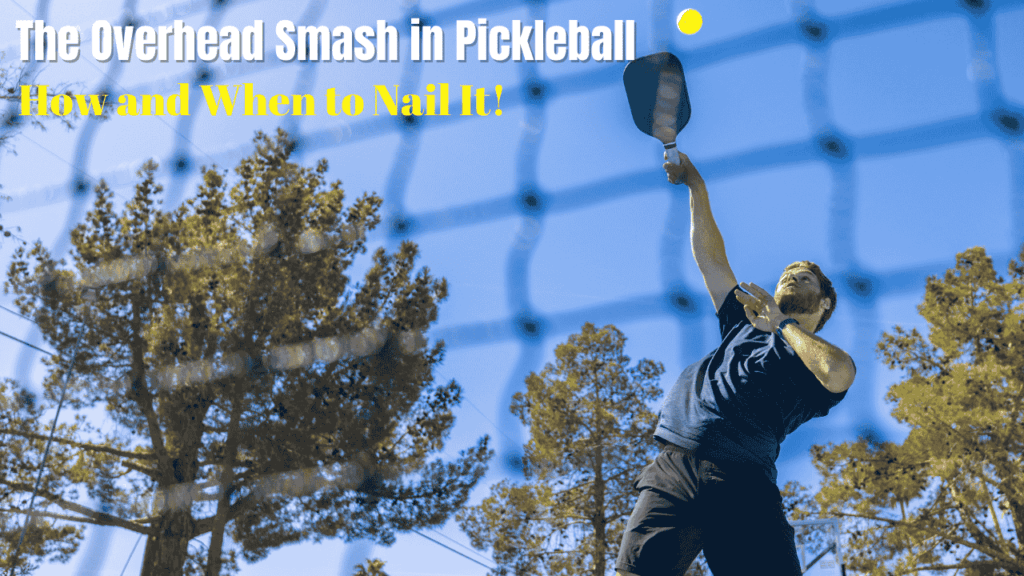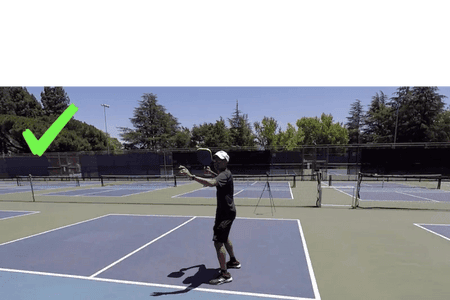No products in the cart.
The Overhead Smash in Pickleball: How and When to Nail It
The overhead shot in pickleball is a powerful downward strike directed towards the opponent’s side of the court. Often, this shot is a return to an opponent’s lob, high bounce, or high return that demands precision and timing.
When performing the overhead smash, the paddle is held extended over the head at maximum height with the elbow kept straight, providing the leverage needed for an effective strike. One key aspect of executing this shot is aiming for an open spot on the opponent’s court, targeting their feet or finding an area away from their body.

It’s critical to avoid backpedaling, which is a dangerous maneuver. Instead, shuffle sideways or turn and run into position. Keep your eyes on the ball and point with your non-paddle hand to track its movement.
As you prepare for the shot, make sure to contact the ball as high as possible and in front of you, transferring weight from your back foot to your front foot. This downward swing, often aided by a wrist flex (or a snap), ensures that the ball has the right amount of speed and angle.
In some cases, a backhand smash may require flexing the wrist backward, adding extra power and control to the shot.
Can You Hit the Overhand Smash In Pickleball?
Yes, hitting an overhand shot is allowed in pickleball for most shots, especially when returning a lob or a high bounce. However, the rulebook has a key exception when it comes to the serve. Overhand serves are not legal in pickleball; instead, you must serve with an underhand motion, ensuring that contact between the paddle and ball occurs below the belly button. This rule differs significantly from tennis, where overhand serves are allowed. Understanding this difference helps players master their game strategy and avoid common mistakes during their serve.
How To Hit It Overhand in Pickleball
The overhead smash is one of the most powerful shots in pickleball, often leaving opponents scrambling.
If you are looking to elevate your game, mastering this shot is key. To execute an effective overhead smash, you’ll need more than just strength.
Technique plays a huge role, and that’s where most players can struggle. Understanding the movement and having a solid foundation can make all the difference.
1. Positioning Yourself for Success
To begin, always be ready for a high ball from your opponent. As the ball approaches, position your feet and align yourself behind it.
This gives you the perfect opportunity to step into the shot. As you get in position, turn your body 90 degrees so that your shoulders and hips face the sideline. This body rotation is crucial to generating the necessary power.

2. The Paddle Setup
Now comes the most important part: positioning the paddle. Hold the paddle behind your head, with your elbow cocked and pointing slightly towards the sky.
The elbow should be parallel to the ground or slightly raised. This is your preparation stage. As the ball gets closer, you’ll want to swing upward, ensuring that your arm is fully extended at the point of contact.
3. Executing the Smash
As the ball meets the paddle, make sure to keep your eyes on it and your head and shoulders up. This will help maintain balance and ensure that the ball doesn’t end up in the net.
The goal is to hit with as much force as possible, mimicking the movement of an overhead smash. Don’t forget to keep your body high and follow through smoothly as you complete the swing.
When Should You Hit Overhand in Pickleball?

Hitting an overhead smash in pickleball can be a game-changer, but knowing when to take the shot is crucial.
You’ll want to wait for the right opportunity. The overhand smash is a more aggressive shot in picklball, typically used when your opponent gives you a weak ball or lobs it high above your shoulders. When you see that ball coming, it’s a signal to move into attack mode.
1. Ideal Situations to Smash
If you are close to the kitchen line, your placement is key. Aim for your opponent’s feet if they are at the mid-court or kitchen line, or smash it hard towards the service line if they are further back.
This helps you create pressure and control the point, leaving little room for your opponent to return the ball.
2. Doubles Play and Confusion
In doubles, things can get tricky when you smash the ball hard and right in the middle of the court. This often causes confusion between your opponents, making them scramble to decide who will return the shot. It’s a great strategy to disrupt their rhythm and take control of the point.
3. Avoid Risky Shots
While the overhead smash is powerful, don’t forget to be smart about it. Remember, more points are lost due to errors or bad shots than won with winners.
When you have the chance, make sure to focus on placing the ball between the lines rather than going for a risky winner. Keep the pressure on your opponent while staying in control.
4. When Not to Smash
There will be times when your opponent hits a high ball, but you are either moving backwards or not in the ideal position.
In these cases, attempting an overhead smash might not be the best option. Instead, focus on returning the ball hard to keep the rally going. Sometimes, just making a solid return is the smartest play.
Are There Other Times When You Can’t Hit Overhand in Pickleball?
There are times in pickleball when you can’t hit an overhand shot, especially during the 2 bounce rule. This rule states that the second hit (the return of serve) and the third hit of a rally must bounce on the ground before you can make contact with the ball.
That means you cannot volley or hit the ball in the air during these two hits, even if your opponent sends a soft, high, and smashable ball your way.
Instead, you have to wait for the ball to bounce before you can spike or smash it, making those shots a little tougher, as pickleballs don’t tend to bounce very high. So, when playing by the rules, remember, the smash comes only after the ball hits the ground following the second and third shots of the rally.
What Is A Spike In Pickleball?
In pickleball, a spike is similar to a volleyball spike, but instead of using a hand, it’s executed with a paddle. The overhand motion sends the pickleball downward with strength and power, aiming to land it in the opponent’s court.
Spikes are usually hit by players close to the kitchen line, making them offensive shots that often result in a winning point, or at least force the opponent into a weak or missed return.
Spikes can be done in several ways, such as a flat slap or by hitting the outside of the ball, similar to a tennis smash, but ultimately it’s an overhead shot designed to finish the point.
Can You Serve Overhand In Pickleball?
In pickleball, you cannot serve with an overhand motion. The rules in the rulebook state that a serve must be exclusively made with an underhand motion. Additionally, your paddle must make contact with the ball at or below your navel.
While you can easily hit an overhand shot during rallies, the only time you cannot do so is during the serve. This rule is designed to keep the game more accessible and maintain the flow of play, ensuring that players are not relying on strong overhand serves as they might in other sports.
Conclusion
Mastering the overhead smash in pickleball isn’t just about power it’s about timing, smart positioning, and knowing when to go for it.
Whether you’re stepping into a lob or aiming for your opponent’s feet, the right technique can turn a good rally into a winning point. Just remember, patience and smart shot selection are key. Practice often, stay focused, and soon you’ll be smashing with confidence!








Add comment